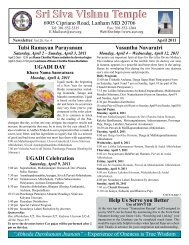GURU (Jupiter) TRANSITION - Sri Siva Vishnu Temple
GURU (Jupiter) TRANSITION - Sri Siva Vishnu Temple
GURU (Jupiter) TRANSITION - Sri Siva Vishnu Temple
You also want an ePaper? Increase the reach of your titles
YUMPU automatically turns print PDFs into web optimized ePapers that Google loves.
<strong>Sri</strong> <strong>Siva</strong> <strong>Vishnu</strong> <strong>Temple</strong>6905 Cipriano Road, Lanham MD 20706Tel: (301) 552-3335 Fax: (301) 552-1204E-Mail: ssvt@ssvt.org Web Site: http://www.ssvt.org<strong>GURU</strong> (<strong>Jupiter</strong>) <strong>TRANSITION</strong>Sunday May 8, 2011Among the Nava-grahas (Nine heavenly bodies), the grahas Guru (<strong>Jupiter</strong>) andSani (Saturn) are believed to have significant influence on the direction and fortunes ofour lives. The Gochara (transition) of these heavenly bodies from one Zodiac to anothermay affect certain Raasis (Moon signs) either positively or negatively. Guru normallymakes a transition about once a year whereas Sani takes about two and half years to doso. Sometimes the transition may occur more often because of the retrogressivemovements of these grahas. This year the forward transition of Guru will take placewithin six months of the last transition. The Moon signs (Raasis) discussed here shouldnot be confused with the Sun signs used in the Western astrology. The Nakshatras (stars)associated with the corresponding Raasi are given in the table below.This year Guru makes a transition from “Meena” (Moon sign Pisces) to “Mesha”(Moon sign Aries) on Sunday May 8 according to North American Panchang. The effectof this transition is more pronounced for those undergoing the "Guru Dashaa". (A briefdiscussion of the Dashaas is given at the end of this write-up.) The transition is likely tohave a potentially negative effect for those born under Mesha Raasi (1st house),Vrishabha Raasi (12th house), Kanya Raasi (8th house) and Kumbha Raasi (3rd house).Those belonging to Meena (2nd house), Dhanus (5th house), Thulaa (7th house), Simha(9th house), and Mithuna (11th house) Raasis are likely to benefit from this transition.For those Raasis that are not mentioned above, the effect will be mixed.Every Graha has a presiding Deity. The presiding Deity for Guru is Lord <strong>Siva</strong> in the formof Lord Dakshinamurthy. Offering prayers to the Graha and to the presiding Deity is oneway to mitigate the negative effects caused by the transition. Offering preparations madeof chickpeas (Kaabuli or Kaalaa Chana), repetitive recitation of the Brihaspati stotram(given below) and the Dakshina Murthy stotra daily and specifically on Thursdays,performing Navagraha Pradakshina (going clockwise around the Navagrahas) and doingPuja to Guru especially on Thursdays are some of the means suggested by elders tominimize the negative effects from the transition. Many devotees also believe that dailyprayers to Hanumaan (for example chanting Hanumaan Chaaleesaa regularly) and toone's own favorite God (Ishta Devata) will also help in reducing the bad effects. For thebenefit of all devotees, the temple will hold special Pujas for Guru and the Navagrahason Sunday May 8.Sunday May 8, 20119:30 AM Ganapati Homam, Navagraha Homam with special emphasis on Guru,Navagraha Abishekham, Lord Dakshinamurthy Aradhana, Archana, Deeparadhana,Prasadam & Raksha distribution @ 1:00 PM
Sponsorship: $ 25Sponsors are requested to collect the Raksha (sanctified thread worn around the rightwrist) from the temple after the Puja.Brihaspati Stotram:Devaanaam Cha Risheenaam Cha Gurum Kaanchana SannibhamBhuddhi Bhootam Trilokesham Tam Namaami BRIHASPATIM.Devotees may also recite the Navagraha Stotra (in the SSVT Commonly RecitedPrayers book) to minimize the Navagraha Doshas (malignant effects of Navagrahas).Raasi Nakshatras in the Raasi Western NameMesha Ashwini, Bharani, Krittika(1) AriesVrishabha Krittika(2,3,4), Rohini, Mrigasira(1,2) TaurusMithuna Mrigasira(3,4), Aardraa, Punarvasu(1,2,3) GeminiKataka Punarvasu(4), Pushya, Aaslesha CancerSimha Makam, Poorvaphalguni, Uttaraphalguni(1) LeoKanya Uttaraphalguni(2,3,4), Hasta, Chitra(1,2) VirgoThulaa Chitra(3,4), Swaati, Vishaakha(1,2,3) LibraVrischika Vishaakha(4), Anuraadhaa, Jyeshtaa ScorpioDhanu Moola, Poorvaashaada, Uttaraashaada(1) SagittariusMakara Uttaraashaada(2,3,4), Sravana, Sravishta(1,2) CapricornKumbha Sravishta(3,4), Satabhisheka, PoorvaBhaadra (1,2,3) AquariusMeena PoorvaBhaadra(4), UttaraBhaadra, Revati PiscesHow to interpret the above table?Raasi is determined by the position of the moon at the place and time of birth. The abovetable tells you the Raasi if you know the part of the Nakshatra (star) you were born under.Each star is divided into four quarters. A Raasi comprises of two and a quarter stars.Numbers in parentheses indicate the quarters of a star that are in a Raasi. If there are noparentheses next to a star, then that means all the four quarters of that star are included inthat Raasi. For instance, Thulaa Raasi is made up of the last two quarters of "Chitra", allof "Swaati" and the first three quarters of "Vishaakha". Makara Raasi is made up of thelast three quarters of "Uttaraashaada", all of "Sravana" and the first two quarters of"Sravishta".DASHAASDashaas are cyclical periods of time spanning several years during which the fruits of ourpast Karmas begin to unfold. There are different Dashaa systems of which the 120-yearDashaa system is the most common. The order in which the Dashaas occur is the samefor all but the starting point varies according to one's birth star (Nakshatra). The durationof the nine Dashaas are: Sun(6 years); Moon(10 years); Mars(7); Rahu(18); <strong>Jupiter</strong>(16);Saturn(19); Mercury(17); Ketu(7); and Venus(20). Each Dashaa is further divided intoseveral sub-periods and the effects of Karma may be more pronounced during some ofthese sub-periods.
















